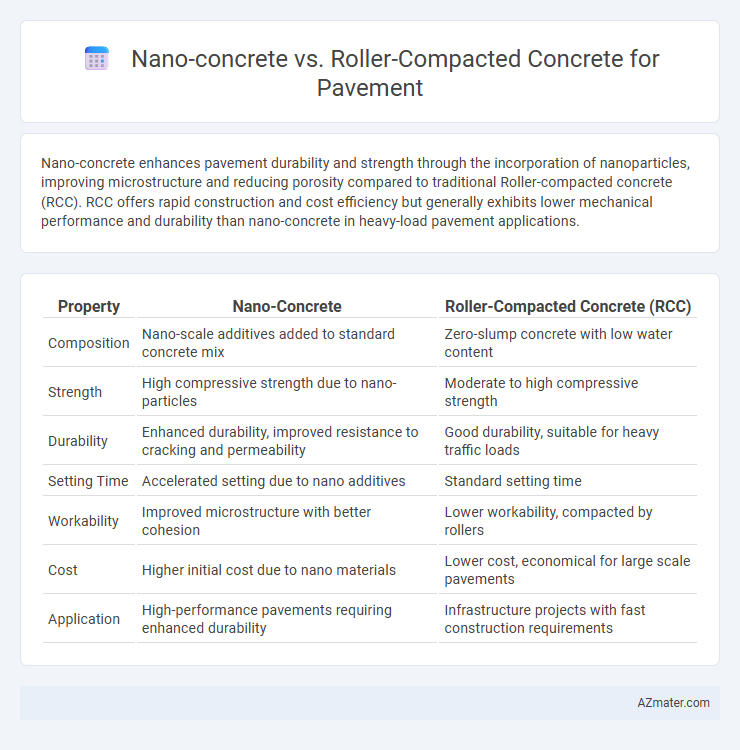Nano-concrete enhances pavement durability and strength through the incorporation of nanoparticles, improving microstructure and reducing porosity compared to traditional Roller-compacted concrete (RCC). RCC offers rapid construction and cost efficiency but generally exhibits lower mechanical performance and durability than nano-concrete in heavy-load pavement applications.
Table of Comparison
| Property | Nano-Concrete | Roller-Compacted Concrete (RCC) |
|---|---|---|
| Composition | Nano-scale additives added to standard concrete mix | Zero-slump concrete with low water content |
| Strength | High compressive strength due to nano-particles | Moderate to high compressive strength |
| Durability | Enhanced durability, improved resistance to cracking and permeability | Good durability, suitable for heavy traffic loads |
| Setting Time | Accelerated setting due to nano additives | Standard setting time |
| Workability | Improved microstructure with better cohesion | Lower workability, compacted by rollers |
| Cost | Higher initial cost due to nano materials | Lower cost, economical for large scale pavements |
| Application | High-performance pavements requiring enhanced durability | Infrastructure projects with fast construction requirements |
Introduction to Pavement Technologies
Nano-concrete enhances pavement durability through the integration of nanomaterials, which improve mechanical strength and reduce permeability compared to conventional mixes. Roller-compacted concrete (RCC) is a cost-effective, fast-placing technology with high density achieved by roller compaction, commonly used for heavy-duty pavements. Both technologies offer distinct advantages in pavement construction, where nano-concrete provides superior performance at a microstructural level and RCC excels in rapid construction for large-scale infrastructure.
Overview of Nano-Concrete
Nano-concrete incorporates nanoparticles like nano-silica to enhance the microstructure, resulting in significantly improved tensile strength, durability, and resistance to shrinkage compared to traditional Roller-Compacted Concrete (RCC). The inclusion of nanoscale materials refines the pore structure and accelerates hydration, which minimizes permeability and enhances the pavement's lifespan under heavy traffic conditions. These properties make nano-concrete a promising advancement in pavement technology, particularly for applications requiring high performance and longevity.
Roller-Compacted Concrete: Basics and Applications
Roller-compacted concrete (RCC) is a dry mix concrete used extensively in pavement construction due to its high compressive strength and rapid placement capabilities. Its applications include heavy-duty pavements such as highways, industrial yards, and airport runways where durability and load-bearing capacity are crucial. The compaction process enhances density and minimizes voids, resulting in improved resistance to deformation and longer service life compared to traditional concrete alternatives.
Material Composition Differences
Nano-concrete incorporates nanoparticles such as nano-silica and nano-titanium dioxide, enhancing cement hydration and resulting in higher strength and durability compared to conventional mixes. Roller-compacted concrete (RCC) relies on a dry mix with lower water content, designed for compaction by rollers to achieve dense, impermeable pavement layers ideal for heavy traffic applications. The fundamental compositional difference lies in nano-concrete's advanced material modifications at the nanoscale, whereas RCC emphasizes optimized aggregate gradation and moisture control for structural performance.
Mechanical Properties Comparison
Nano-concrete exhibits significantly enhanced mechanical properties compared to roller-compacted concrete (RCC), including higher compressive strength and improved tensile capacity due to the nano-scale reinforcement of cementitious matrices. The incorporation of nanoparticles in nano-concrete results in a denser microstructure, reducing porosity and enhancing durability, which directly impacts the load-bearing performance and reduces crack propagation under traffic loads. Roller-compacted concrete, while efficient for rapid construction, generally demonstrates lower flexural strength and modulus of elasticity than nano-concrete, making nano-concrete more suitable for high-performance pavement applications requiring superior mechanical resilience.
Durability and Longevity
Nano-concrete incorporates nanoparticles that enhance the microstructure, resulting in significantly improved durability and resistance to chemical attacks compared to conventional Roller-compacted concrete (RCC). RCC offers excellent compressive strength and rapid construction benefits but may demonstrate reduced long-term durability in harsh environments due to its coarser matrix and potential for higher permeability. The integration of nanomaterials in concrete formulations can extend pavement service life by reducing crack propagation, improving abrasion resistance, and enhancing resistance to freeze-thaw cycles, making nano-concrete a superior option for durable, long-lasting pavements.
Construction Techniques and Workability
Nano-concrete utilizes nanoparticles such as nano-silica to enhance the microstructure, resulting in improved strength and durability, which requires precise mixing techniques to ensure uniform dispersion of nanoparticles. Roller-compacted concrete (RCC) employs a dry mix consistency placed with heavy rollers, allowing rapid construction of pavements with high compaction and minimal finishing, but it demands careful control of moisture content and compaction effort for optimal workability. The construction technique of nano-concrete emphasizes advanced mixing and curing processes to optimize nanoparticle integration, while RCC relies on traditional pavement construction equipment and methods focused on efficient layering and compaction.
Cost Efficiency Analysis
Nano-concrete demonstrates superior cost efficiency in pavement applications due to its enhanced durability and reduced maintenance requirements, resulting in lower lifecycle costs despite higher initial material expenses. Roller-compacted concrete (RCC) offers a more economical option with lower upfront costs and faster construction times, but often incurs increased maintenance expenses over the pavement lifespan. A comprehensive cost efficiency analysis reveals that nano-concrete is more cost-effective for long-term pavement solutions, while RCC suits projects prioritizing immediate budget constraints.
Environmental Impact Assessment
Nano-concrete significantly reduces carbon emissions compared to roller-compacted concrete (RCC) due to its enhanced durability and lower cement content, leading to a smaller carbon footprint during production and service life. RCC, while efficient in rapid placement and compaction, often requires higher cement quantities, contributing to greater environmental degradation and increased greenhouse gas emissions. Life cycle assessment studies highlight nano-concrete's potential to minimize resource consumption and carbon output, making it a more sustainable choice for pavement construction.
Suitability for Various Pavement Applications
Nano-concrete offers superior durability and enhanced microstructural properties, making it highly suitable for high-traffic urban pavements and areas requiring rapid construction and high strength. Roller-compacted concrete (RCC) excels in heavy-duty industrial and highway pavements due to its cost-effectiveness, ease of placement, and strong load-bearing capacity. The choice between nano-concrete and RCC depends on specific pavement demands such as load intensity, curing time, and environmental exposure conditions.

Infographic: Nano-concrete vs Roller-compacted concrete for Pavement
 azmater.com
azmater.com